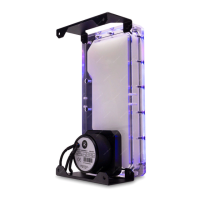- 38 -
Exceedingly high CPU temperatures are usually the symptom of a
malfunctioning liquid cooling loop, assuming the contact between
the CPU heat spreader and water block itself is adequate, and that
the water is appropriately cooled within the radiator.
High CPU temperatures can occur in the following scenarios.
Malfunctioning or broken-down water pump: The symptoms
usually include a rapid spike in temperature when stressing your
CPU to the maximum. Make sure the pump is plugged into the
power connector, and that liquid is indeed flowing through the
system. You should feel the pump vibrating beneath your hand.
Observe the flow indicator or flow meter readings if present.
Malfunctioning or broken-down cooling fans: The symptoms
usually include a rapid spike in temperature when stressing your
CPU to the maximum. Make sure the cooling fans are plugged into
the power connector hub and that the blades are indeed rotating.
Kink in the liquid cooling tube: The symptoms are very similar
to those described above. Thin-walled tubing may collapse
easily under low radius turns or when obstructed by other
computer chassis elements, such as side panel doors. Check
the tubing for any signs of kinks that could restrict the flow.
Usually, this will not be the case when using original tubing.
Clogged microchannels in the water block: Microchannels get
clogged easily with various dirt particles and impurities, especially
with plasticizer powder, leached from the tubing (when using
inauthentic tubing). The symptoms usually include a rapid spike in
temperature when stressing your CPU to the maximum, and flow
rates that are very low. Visually inspect the water block internals for
any buildup or contamination and clean the system if necessary. In
case you have the water block with a translucent acrylic top, this
inspection can be done without disassembling the system.
Thermal Interface Material not/improperly applied: The
lack of - or even too much TIM (Thermal Interface Material/
thermal paste/thermal grease) - may result in the overheating
of your CPU. If that is the case, please refer to STEP 2 in the
chapter Installing the Water Block.
Cooling liquid (coolant) is freezing: Running the system in a subzero
environment may lead to liquid freezing. The symptoms include
an initial rapid spike in the temperatures when stressing your CPU,
followed by a substantial temperature drop after the liquid partially
thaws. Always make sure the system is operating in an environment
where ambient (room) temperature doesn’t drop below 5°C.
Another culprit for exceedingly high CPU temperatures could be
a partially or completely defective CPU. Some CPUs run at higher
temperatures than others, and overheating can occur in the
following scenario.
Poor thermal contact within the CPU itself: Some CPUs
(such as Intel LGA 1151 socket based Skylake, Intel LGA 1150
based Haswell and older, and socket LGA 1155 based Ivy Bridge)
are notorious for their poor thermal contact between the CPU
die and the heat spreader (IHS) due to the use of poor TIM. This
is the problem of the processor itself, not the CPU liquid cooling
unit. These CPUs are known to get very hot (80°C +), even on
factory-set frequencies. For the best performance, it is usually
recommended to replace the TIM between the die and the
IHS or even run the processor de-lidded. Both options require
hazardous IHS removal that will void the processor’s warranty
but can lead to a temperature decrease of 30°C or more.
TROUBLESHOOTING

